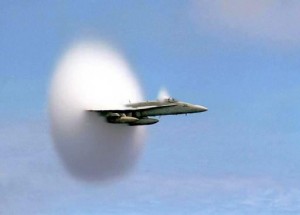Now let’s take explore how, even though heat can move from one object to another, it doesn’t necessarily mean that the temperature of the objects will change. You may ask, “What? Heat can move from one object to another without temperature changing one little bit?!?!” We’re going to take a look at one of the ways heat can move while the thermometer doesn’t.
When things change phase (change from solid to liquid or liquid to gas or… well, you get the picture) the temperature of those objects don’t change. If you were able to take the temperature of water as it changed from a solid (ice) to a liquid you would notice that the temperature of that piece of ice will stay at about 32° F until that piece of ice was completely melted. The temperature would not increase at all. Even if that ice was in an oven, the temperature would stay the same. Once all the solid ice had disappeared, then you would see the temperature of the puddle of water increase.
By the way, as the ice is melting, from where is heat being transferred? Heat is being transferred, by conduction, from the air.
One key distinction is that objects don’t contain heat, but they contain energy. Heat is the transfer of energy from from one object to another, or from one system to another, like a hot cup of coffee to the cool ambient air. Heat can change the temperature of objects when it transfers the energy. In the example with the coffee cup, it lowered the temperature of the coffee.
Imagine putting a sponge under a slowly running faucet. The sponge would continue to fill with water until it reached a certain point and then water started to drip from it. You could say that the sponge had a water capacity. It could hold so much water before it couldn’t hold any more and the water started dripping out.
Please login or register to read the rest of this content.



 The FBD of projectiles is simply a downward pointing arrow to indicate the weight. If it looks strange to have a force not in the direction of the object’s travel path, just remember that a force isn’t needed to sustain motion… it’s actually the opposite! Objects stop moving because of the forces applied to it. The FBD are always a snapshot of the forces acting on the object in that moment. The object can be moving in one direction and the force acting in another.
The FBD of projectiles is simply a downward pointing arrow to indicate the weight. If it looks strange to have a force not in the direction of the object’s travel path, just remember that a force isn’t needed to sustain motion… it’s actually the opposite! Objects stop moving because of the forces applied to it. The FBD are always a snapshot of the forces acting on the object in that moment. The object can be moving in one direction and the force acting in another. Since you've worked so hard, I thought you'd enjoy making a marshmallow launcher just for fun. You can calculate the horizontal and vertical acceleration based on the time of flight, you can also figure out the initial speed based on how far it went, or you can just make it and have fun with it. Here it is:
Since you've worked so hard, I thought you'd enjoy making a marshmallow launcher just for fun. You can calculate the horizontal and vertical acceleration based on the time of flight, you can also figure out the initial speed based on how far it went, or you can just make it and have fun with it. Here it is: This experiment is for Advanced Students. For ages, people have been hurling rocks, sticks, and other objects through the air. The trebuchet came around during the Middle Ages as a way to break through the massive defenses of castles and cities. It’s basically a gigantic sling that uses a lever arm to quickly speed up the rocks before letting go. A trebuchet is typically more accurate than a catapult, and won’t knock your kid’s teeth out while they try to load it.
This experiment is for Advanced Students. For ages, people have been hurling rocks, sticks, and other objects through the air. The trebuchet came around during the Middle Ages as a way to break through the massive defenses of castles and cities. It’s basically a gigantic sling that uses a lever arm to quickly speed up the rocks before letting go. A trebuchet is typically more accurate than a catapult, and won’t knock your kid’s teeth out while they try to load it. Let’s take a good look at Newton’s Laws in motion while making something that flies off in both directions. This experiment will pop a cork out of a bottle and make the cork fly go 20 to 30 feet, while the vehicle moves in the other direction!
Let’s take a good look at Newton’s Laws in motion while making something that flies off in both directions. This experiment will pop a cork out of a bottle and make the cork fly go 20 to 30 feet, while the vehicle moves in the other direction! The image shown here is a real picture of an aircraft as it breaks the sound barrier. This aircraft is passing the speed at which sounds travel. The white cloud you see in the photo is related to the shock waves that are forming around the craft as it moves into supersonic speeds. Because the aircraft is moving through air, which is a gas, the gas can compress and results in a shock wave.
The image shown here is a real picture of an aircraft as it breaks the sound barrier. This aircraft is passing the speed at which sounds travel. The white cloud you see in the photo is related to the shock waves that are forming around the craft as it moves into supersonic speeds. Because the aircraft is moving through air, which is a gas, the gas can compress and results in a shock wave.